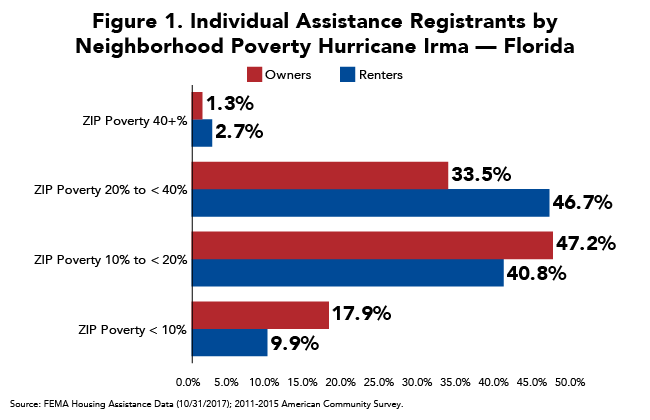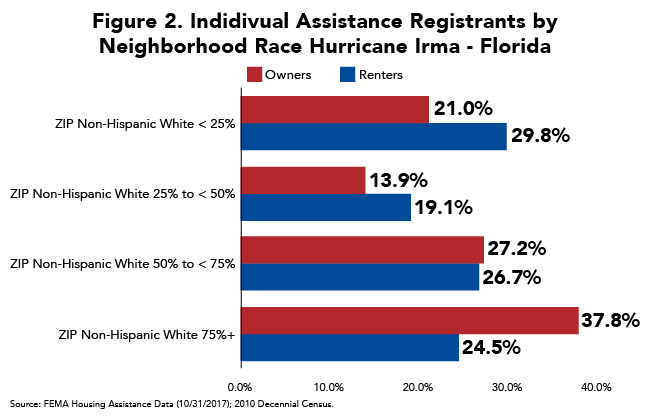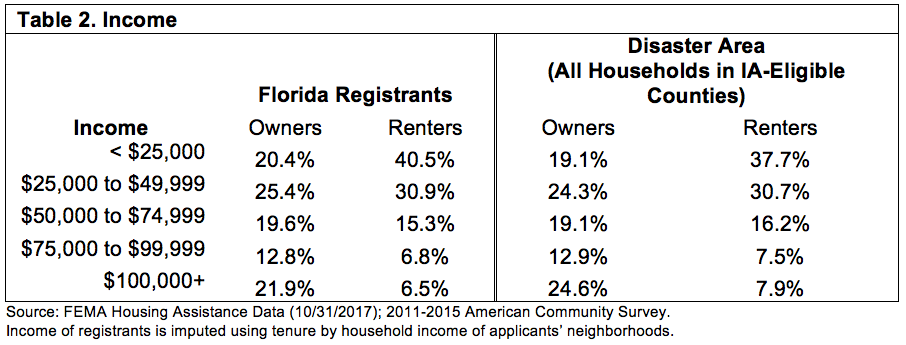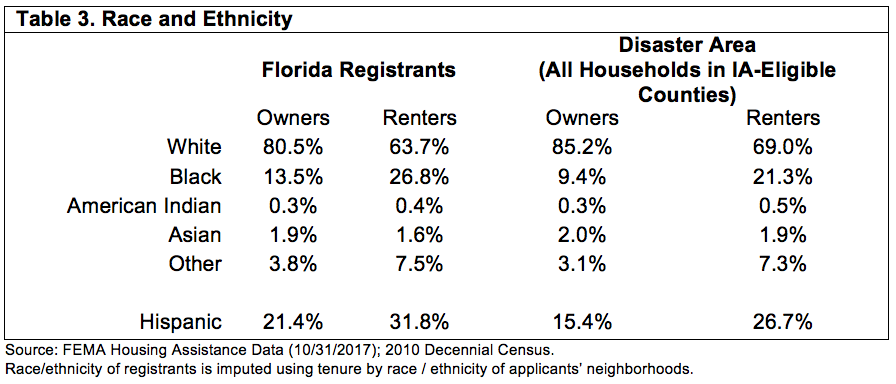FEMA recently released data about registrations for assistance from its Individuals and Households Program (IHP) after Hurricanes Harvey and Irma. IHP provides approved registrants with assistance for rent, home repair (for homeowners), or other serious disaster-related needs, such as medical care, transportation, storage, or essential household items. The data provide a summary of the number and ownership status of registrants, extent of damage, and the dollar amounts approved for assistance. Like NLIHC’s previous analysis of Hurricane Harvey registrants in Texas, the data from Florida show that renters are disproportionately represented among registrants, and racial and ethnic minorities and households with limited financial resources may face greater difficulty in planning for, coping with, and recovering from disaster.
As of October 31, more than 2.5 million registrants in Florida have applied for assistance, 45% of whom are owners and 55% are renters (table 1). The data demonstrate that a disproportionate percentage of renters have registered, as owners comprise 65% of all households in the disaster area and renters comprise 35%. FEMA will continue to accept applications for individual assistance until November 24, 2017.
 Source: FEMA Housing Assistance Data (10/31/2017); 2011-2015 American Community Survey.
IA = Individual Assistance.
Source: FEMA Housing Assistance Data (10/31/2017); 2011-2015 American Community Survey.
IA = Individual Assistance.Of the registrants, 287,226 owners and 412,923 renters have been approved for assistance. Some registrants’ approvals are pending, while others have been found ineligible. The causes of ineligibility, which can include non-damage related reasons like inadequate identification or inadequate proof of ownership or occupancy, are not provided in the current data. At the same time, physical damage inspections are completed for only 14% of owner registrants and 17% of renter registrants. We therefore focus on those who have applied for assistance.
The two following graphs show the distribution of renter and owner registrants across neighborhoods categorized by their by poverty rate (figure 1) and racial & ethnic composition (figure 2). To date, nearly half of renter registrants and 35% of owner registrants live in ZIP codes with a poverty rate of at least 20%. In addition, nearly half of renter registrants and 35% of owner registrants live in majority-minority ZIP codes (non-Hispanic White households account for less than 50% of all households).
 Source: FEMA Housing Assistance Data (10/31/2017); 2011-2015 American Community Survey
Source: FEMA Housing Assistance Data (10/31/2017); 2011-2015 American Community Survey Source: FEMA Housing Assistance Data (10/31/2017); 2010 Decennial Census
Source: FEMA Housing Assistance Data (10/31/2017); 2010 Decennial CensusFEMA’s currently available data do not include the incomes of individual registrants. If we assume that registrants reflect their neighborhoods, then renters are more likely than owners to have low incomes. More than 40% of renter registrants have an annual household income of less than $25,000, while another 31% have incomes between $25,000 and $50,000 (table 2). Twenty percent of owner registrants have incomes below $25,000, and 25% have incomes between $25,000 and $50,000.
 Source: FEMA Housing Assistance Data (10/31/2017); 2011-2015 American Community Survey.
Income of registrants is imputed using tenure by household income of applicants’ neighborhoods.
Source: FEMA Housing Assistance Data (10/31/2017); 2011-2015 American Community Survey.
Income of registrants is imputed using tenure by household income of applicants’ neighborhoods.The majority of registrants are White, because they account for the majority of the population in Florida’s disaster area. Blacks and Hispanics, however, appear to be disproportionately represented among registrants, compared to their share of households in the disaster area. Twenty-seven percent of renter registrants are black and 32% are Hispanic, while 13% of owner registrants are black and 21% are Hispanic (table 3).
 Source: FEMA Housing Assistance Data (10/31/2017); 2010 Decennial Census.
Race/ethnicity of registrants is imputed using tenure by race / ethnicity of applicants’ neighborhoods.
Source: FEMA Housing Assistance Data (10/31/2017); 2010 Decennial Census.
Race/ethnicity of registrants is imputed using tenure by race / ethnicity of applicants’ neighborhoods.Recovery from disaster can be challenging for any family. The limited resources of low income households makes recovery even more difficult. Past housing recovery efforts have included a bias in the allocation of federal funds toward homeownership and a failure to address the needs of low income households. The Disaster Housing Recovery Coalition is a group of more than 200 local, state, and national organizations working to ensure that the needs of renters and low income households are met, in part by calling on Congress to provide adequate funding to ensure that all households receive the affordable and accessible housing they need and by playing an active oversight role to ensure resources are allocated fairly to meet the needs of low income people can communities.
